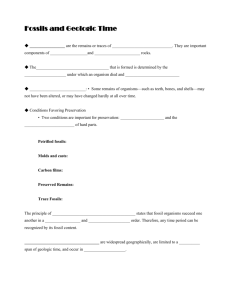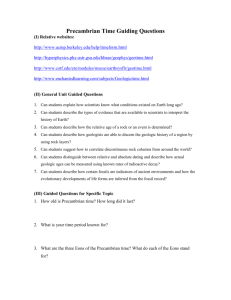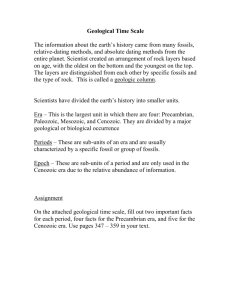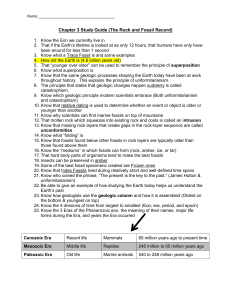Chapter 30 Views of the Earths Past
advertisement
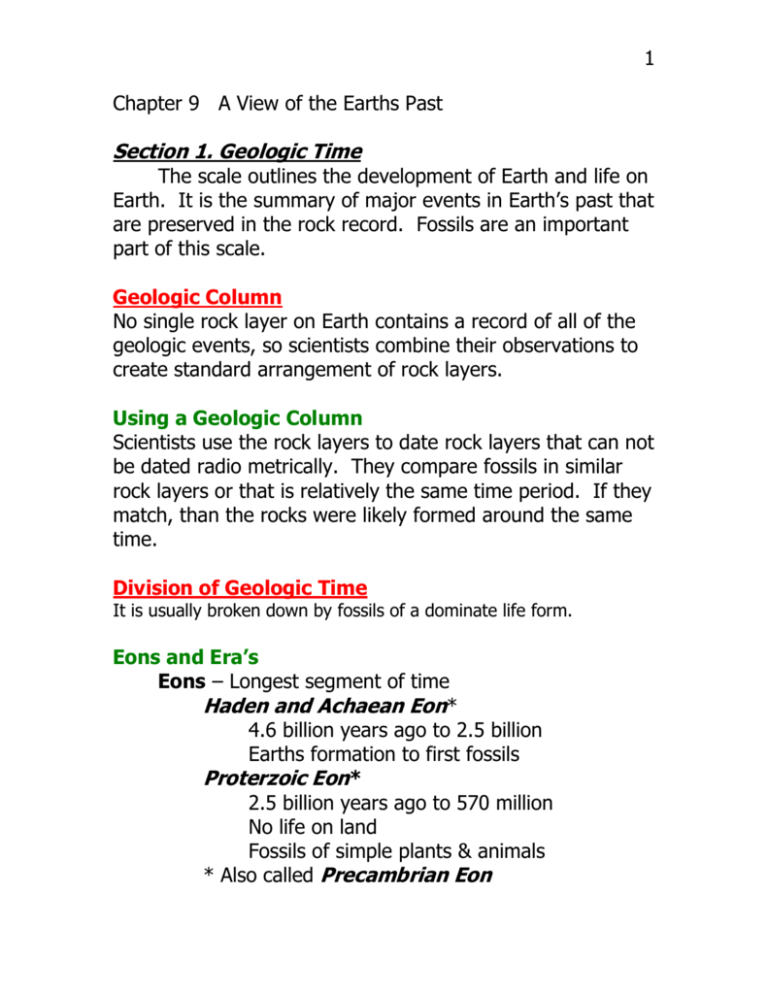
1 Chapter 9 A View of the Earths Past Section 1. Geologic Time The scale outlines the development of Earth and life on Earth. It is the summary of major events in Earth’s past that are preserved in the rock record. Fossils are an important part of this scale. Geologic Column No single rock layer on Earth contains a record of all of the geologic events, so scientists combine their observations to create standard arrangement of rock layers. Using a Geologic Column Scientists use the rock layers to date rock layers that can not be dated radio metrically. They compare fossils in similar rock layers or that is relatively the same time period. If they match, than the rocks were likely formed around the same time. Division of Geologic Time It is usually broken down by fossils of a dominate life form. Eons and Era’s Eons – Longest segment of time Haden and Achaean Eon* 4.6 billion years ago to 2.5 billion Earths formation to first fossils Proterzoic Eon* 2.5 billion years ago to 570 million No life on land Fossils of simple plants & animals * Also called Precambrian Eon 2 Phanerozic Eon About 570 to present Era- a long period of time that is further divided Paleozoic Era Age of Invertebrates 543 million years ago Mesozoic Era Age of Reptiles 248 million years ago Cenozoic Era Age of Mammals 65 million years ago to present Periods and Epochs Period – are a shorter period of time further divided usually named for the place where a fossil was found. Cambrian 543 million years ago Ordovician 490 million years ago Silurian 443 million years ago Devonian 417 million years ago Carboniferous Mississippian 354 million years ago Pennsylvanian 323 million years ago Permian 290 million years ago Triassic 248 million years ago 3 Jurassic 206 million years ago Cretaceous 144 million years ago Tertiary Paleocene 65 million years ago Neocene 24 million years ago Quaternary 2 million years ago to present Epochs – the next smallest time division Early, Middle & Late Cenozoic Era is the only one with names Paleocene 65 million years ago Eocene 54.8 million years ago Oligocene 33.7 million years ago Miocene 24 million years ago Pliocene 5 million years ago Pleistocene about 2 million Holocene started about 10 thousand years ago to present Age- even a smaller division – usually a new fossil was introduced. Section 2 Precambrian Time and the Paleozoic Era Evolution The process of change that produces new life forms Charles Darwin (1859) Proposed: Surviving offspring inherited favorable traits to further survive the environment 4 An organism adapts to the environment or becomes extinct Natural Selection which is the processes that allows animals and plants that are best suited to survive to reproduce and pass on their traits Time can create new species Species – a group of organisms that can reproduce fertile offspring There is tremendous amount of debate over whether the changes in evolution take place quickly or if they are slow and steady. The best scientific evidence now points to Punctuated Equilibrium. Which involves a slow natural process then some kind of change happens to the environment and there is a series of very rapid changes or Bursts of Evolution. Precambrian Life It is the time period from 4.6 billion to 542 million years ago. This includes about 88% of Earth’s history occurred during this time. The rock record has been deformed so much that scientists can not interpret what took place and when it took place. Precambrian Rocks Shields – large areas of Precambrian exposed rocks Precambrian Life Very little life has been discovered. The life forms that were mostly found were cyanobactria in stromatolites or layered reef like deposits.
